CardioResp Device: Hardware and Firmware of an Embedded Wearable for Real-Time ECG and Respiration in Dynamic Settings
Abstract
1. Introduction
2. Related Work
3. System Architecture and Methods
3.1. Hardware Design
3.1.1. ECG AFE
3.1.2. IMU
3.1.3. PO and Temperature Sensor
3.1.4. Processing Unit
3.2. Firmware Design
3.2.1. ECG Signal Processing
3.2.2. IMU Processing
3.2.3. PO Processing
3.2.4. BLE Transmission
4. Experimental Protocols and Validation
4.1. Test 1
4.2. Test 2
4.3. Test 3
5. Results
5.1. Hardware-Level Performance
5.2. Cardiac and Respiration Processing Performance
5.2.1. Performance in Stationary States
5.2.2. Performance in Dynamic States
5.2.3. Ambulatory Monitoring
6. Discussion
7. Conclusions
Author Contributions
Funding
Institutional Review Board Statement
Informed Consent Statement
Data Availability Statement
Acknowledgments
Conflicts of Interest
References
- United Nations, Department of Economic and Social Affairs (Population Division). World Population Ageing 2013; Technical Reports; United Nations, Department of Economic and Social Affairs (Population Division): New York, NY, USA, 2013. [Google Scholar]
- Soh, P.J.; Vandenbosch, G.A.; Mercuri, M.; Schreurs, D.M.P. Wearable wireless health monitoring: Current developments, challenges, and future trends. IEEE Microw. Mag. 2015, 16, 55–70. [Google Scholar] [CrossRef]
- Milenković, A.; Otto, C.; Jovanov, E. Wireless sensor networks for personal health monitoring: Issues and an implementation. Comput. Commun. 2006, 29, 2521–2533. [Google Scholar] [CrossRef]
- Philip, N.Y.; Rodrigues, J.J.; Wang, H.; Fong, S.J.; Chen, J. Internet of Things for in-home health monitoring systems: Current advances, challenges and future directions. IEEE J. Sel. Areas Commun. 2021, 39, 300–310. [Google Scholar] [CrossRef]
- Andrade, A.; Cabral, A.T.; Bellini, B.; Rodrigues, V.F.; da Rosa Righi, R.; da Costa, C.A.; Barbosa, J.L.V. IoT-based vital sign monitoring: A literature review. Smart Health 2024, 32, 100462. [Google Scholar] [CrossRef]
- Tang, Y.; Chen, Z.; Li, A.; Zheng, T.; Lin, Z.; Xu, J.; Lv, P.; Sun, Z.; Gao, Y. Merit: Multimodal wearable vital sign waveform monitoring. arXiv 2024, arXiv:2410.00392. [Google Scholar] [CrossRef]
- Hasan, S.; Pantha, T.; Arafat, M.A. Design and development of a cost-effective portable IoT enabled multi-channel physiological signal monitoring system. Biomed. Eng. Adv. 2024, 7, 100124. [Google Scholar] [CrossRef]
- Do, C.T.; Khai, N.D.; Tuan, D.N.; Chau, P.H.M.; Thanh, N.T.; Le, A.N.; Nguyen, V.D.; Van Chien, T. IoT-Powered Mental Healthcare: Sleep State Analyzing and Monitoring based on EEG Signals. IEEE Access 2025, 13, 66888–66906. [Google Scholar]
- Kim, D.; Lee, J.; Park, M.K.; Ko, S.H. Recent developments in wearable breath sensors for healthcare monitoring. Commun. Mater. 2024, 5, 41. [Google Scholar] [CrossRef]
- Judice, A.; Malhotra, S.; Sharma, M. Recent advancements in wearable antennas and its future directions. In Proceedings of the 2024 11th International Conference on Reliability, Infocom Technologies and Optimization (Trends and Future Directions) (ICRITO), Noida, India, 14–15 March 2024; IEEE: New York, NY, USA, 2024; pp. 1–6. [Google Scholar]
- Cheng, J.; Ma, T.; Xue, N.; Qin, B.; Zhou, W.; Sun, X. Advancements in Wearable Sensor Technology for Remote Health Monitoring. In Proceedings of the 2024 IEEE 10th World Forum on Internet of Things (WF-IoT), Ottawa, ON, Canada, 10–13 November 2024; IEEE: New York, NY, USA, 2024; pp. 1–5. [Google Scholar]
- Abid, M.H.; Talin, I.A. IoT-Based ECG Monitoring System on Smartphones. In Proceedings of the 2024 International Conference on Advances in Computing, Communication, Electrical, and Smart Systems (iCACCESS), Dhaka, Bangladesh, 8–9 March 2024; pp. 1–5. [Google Scholar] [CrossRef]
- He, C.; Fan, X.; Li, Y. Toward Ubiquitous Healthcare Services with a Novel Efficient Cloud Platform. IEEE Trans. Biomed. Eng. 2013, 60, 230–234. [Google Scholar] [CrossRef]
- Elhanashi, A.; Dini, P.; Saponara, S.; Zheng, Q. Advancements in TinyML: Applications, Limitations, and Impact on IoT Devices. Electronics 2024, 13, 3562. [Google Scholar] [CrossRef]
- Haghayegh, F.; Norouziazad, A.; Haghani, E.; Feygin, A.A.; Rahimi, R.H.; Ghavamabadi, H.A.; Sadighbayan, D.; Madhoun, F.; Papagelis, M.; Felfeli, T.; et al. Revolutionary Point-of-Care Wearable Diagnostics for Early Disease Detection and Biomarker Discovery through Intelligent Technologies. Adv. Sci. 2024, 11, 2400595. [Google Scholar] [CrossRef]
- Srivastav, A.K.; Das, P.; Srivastava, A.K. Biotech and IoT: An Introduction Using Cloud-Driven Labs; Springer: Berlin/Heidelberg, Germany, 2024. [Google Scholar]
- Bhuvaneshwari, V.; Sadaieswaran, R.; Malathi, P.; Legapriyadharshini, N.; Thirumalaikumari, T.; Raja, S. IoT-Enhanced Innovations in Drug Delivery Systems for Targeted Therapy in Autoimmune Disorders. In Proceedings of the 2024 10th International Conference on Advanced Computing and Communication Systems (ICACCS), Coimbatore, India, 14–15 March 2024; IEEE: New York, NY, USA, 2024; Volume 1, pp. 1275–1281. [Google Scholar]
- Pandurangan, P.; Rakshi, A.D.; Sundar, M.S.A.; Samrat, A.V.; Meenambiga, S.; Vedanarayanan, V.; Meena, R.; Namasivayam, S.K.R.; Moovendhan, M. Integrating cutting-edge technologies: AI, IoT, blockchain and nanotechnology for enhanced diagnosis and treatment of colorectal cancer-A review. J. Drug Deliv. Sci. Technol. 2024, 91, 105197. [Google Scholar] [CrossRef]
- van der Stam, J.A.; Mestrom, E.H.; Scheerhoorn, J.; Jacobs, F.; de Hingh, I.H.; van Riel, N.A.; Boer, A.K.; Scharnhorst, V.; Nienhuijs, S.W.; Bouwman, R.A. Accuracy of vital parameters measured by a wearable patch following major abdominal cancer surgery. Eur. J. Surg. Oncol. 2022, 48, 917–923. [Google Scholar] [CrossRef]
- Stevens, G.; Larmuseau, M.; Damme, A.V.; Vanoverschelde, H.; Heerman, J.; Verdonck, P. Feasibility study of the use of a wearable vital sign patch in an intensive care unit setting. J. Clin. Monit. Comput. 2025, 39, 245–256. [Google Scholar] [CrossRef]
- Montes, J.; Young, J.C.; Tandy, R.; Navalta, J.W. Reliability and validation of the hexoskin wearable bio-collection device during walking conditions. Int. J. Exerc. Sci. 2018, 11, 806. [Google Scholar] [CrossRef]
- Wei, J.C.; van den Broek, T.J.; van Baardewijk, J.U.; van Stokkum, R.; Kamstra, R.J.; Rikken, L.; Gijsbertse, K.; Uzunbajakava, N.E.; van den Brink, W.J. Validation and user experience of a dry electrode based Health Patch for heart rate and respiration rate monitoring. Sci. Rep. 2024, 14, 23098. [Google Scholar] [CrossRef]
- Momota, M.M.R.; Morshed, B.I.; Ferdous, T.; Fujiwara, T. Fabrication and characterization of inkjet printed flexible dry ECG electrodes. IEEE Sens. J. 2023, 23, 7917–7928. [Google Scholar] [CrossRef]
- Make, B.J.; Yawn, B.P. Breathing life into COPD management: Ongoing monitoring, pulmonary rehabilitation, and individualized care. Chest 2018, 154, 980–981. [Google Scholar] [CrossRef]
- Zulkifli, N.A.B.; Jeong, W.; Kim, M.; Kim, C.; Ko, Y.H.; Hyun, D.C.; Lee, S. 3D-printed magnetic-based air pressure sensor for continuous respiration monitoring and breathing rehabilitation. Soft Sci. 2024, 4, 20. [Google Scholar] [CrossRef]
- Brinkman, J.E.; Toro, F.; Sharma, S. Physiology, Respiratory Drive; StatPearls Publishing: Treasure Island, FL, USA, 2018. [Google Scholar]
- Karlen, W.; Raman, S.; Ansermino, J.M.; Dumont, G.A. Multiparameter respiratory rate estimation from the photoplethysmogram. IEEE Trans. Biomed. Eng. 2013, 60, 1946–1953. [Google Scholar] [CrossRef]
- Utsha, U.T.; Morshed, B.I. Edge-Computing Enabled Real-Time Respiratory Monitoring and Breathing Pattern Detection. In Proceedings of the 2024 IEEE 20th International Conference on Body Sensor Networks (BSN), Chicago, IL, USA, 15–17 October 2024; IEEE: New York, NY, USA, 2024; pp. 1–4. [Google Scholar]
- Karkouli, G.; Douros, K.; Moriki, D.; Moutsatsou, P.; Giannopoulou, I.; Maratou, E.; Koumpagioti, D. Dysfunctional breathing in children: A literature review. Children 2024, 11, 556. [Google Scholar] [CrossRef]
- Loveridge, B.; West, P.; Kryger, M.; Anthonisen, N. Alteration in breathing pattern with progression of chronic obstructive pulmonary disease. Am. Rev. Respir. Dis. 1986, 134, 930–934. [Google Scholar] [CrossRef]
- Vicente, B.A.; Sebastião, R.; Sencadas, V. Wearable devices for respiratory monitoring. Adv. Funct. Mater. 2024, 34, 2404348. [Google Scholar] [CrossRef]
- De Fazio, R.; Stabile, M.; De Vittorio, M.; Velázquez, R.; Visconti, P. An overview of wearable piezoresistive and inertial sensors for respiration rate monitoring. Electronics 2021, 10, 2178. [Google Scholar] [CrossRef]
- Meena, J.S.; Choi, S.B.; Jung, S.B.; Kim, J.W. Electronic textiles: New age of wearable technology for healthcare and fitness solutions. Mater. Today Bio 2023, 19, 100565. [Google Scholar] [CrossRef]
- Blanco-Almazán, D.; Groenendaal, W.; Catthoor, F.; Jané, R. Chest movement and respiratory volume both contribute to thoracic bioimpedance during loaded breathing. Sci. Rep. 2019, 9, 20232. [Google Scholar] [CrossRef]
- Berkebile, J.A.; Mabrouk, S.A.; Ganti, V.G.; Srivatsa, A.V.; Sanchez-Perez, J.A.; Inan, O.T. Towards estimation of tidal volume and respiratory timings via wearable-patch-based impedance pneumography in ambulatory settings. IEEE Trans. Biomed. Eng. 2021, 69, 1909–1919. [Google Scholar] [CrossRef]
- Qiu, C.; Wu, F.; Han, W.; Yuce, M.R. A wearable bioimpedance chest patch for real-time ambulatory respiratory monitoring. IEEE Trans. Biomed. Eng. 2022, 69, 2970–2981. [Google Scholar] [CrossRef]
- Sharan, R.V.; Takeuchi, H.; Kishi, A.; Yamamoto, Y. Macro-Sleep Staging with ECG-Derived Instantaneous Heart Rate and Respiration Signals and Multi-Input 1-D CNN–BiGRU. IEEE Trans. Instrum. Meas. 2024, 73, 1–12. [Google Scholar] [CrossRef]
- Krishnapriya, G.B.; Ponnalagu, R.N.; Goel, S. A Resource-Efficient Time-Domain-Based Algorithm to Estimate Respiration Rate from Single-Lead ECG Signal. IEEE Open J. Instrum. Meas. 2025, 4, 1–9. [Google Scholar] [CrossRef]
- Wang, Y.; Liu, H.; Xiang, W.; Shui, Y.; Guo, L.; Zhou, M.; Pang, Y. A novel non-contact respiration and heartbeat detection method using frequency-modulated continuous wave radar. IEEE Sens. J. 2024, 24, 10434–10446. [Google Scholar] [CrossRef]
- Alves, R.; van Meulen, F.; Overeem, S.; Zinger, S.; Stuijk, S. Thermal Cameras for Continuous and Contactless Respiration Monitoring. Sensors 2024, 24, 8118. [Google Scholar] [CrossRef]
- Vincent, K.; Jing, N.; Wang, L. AcBreath: In-Hand Free Acoustic Breath Signal Reconstruction using Variational AutoEncoder. IEEE Sens. J. 2024, 25, 4908–4916. [Google Scholar] [CrossRef]
- Dan, G.; Zhao, J.; Chen, Z.; Yang, H.; Zhu, Z. A Novel Signal Acquisition System for Wearable Respiratory Monitoring. IEEE Access 2018, 6, 34365–34371. [Google Scholar] [CrossRef]
- Monaco, V.; Giustinoni, C.; Ciapetti, T.; Maselli, A.; Stefanini, C. Assessing Respiratory Activity by Using IMUs: Modeling and Validation. Sensors 2022, 22, 2185. [Google Scholar] [CrossRef]
- Rousanoglou, E.; Foskolou, A.; Emmanouil, A.; Boudolos, K. Inertial Sensing of the Abdominal Wall Kinematics during Diaphragmatic Breathing in Head Standing. Biomechanics 2024, 4, 63–83. [Google Scholar] [CrossRef]
- Gollee, H.; Chen, W. Real-time detection of respiratory activity using an inertial measurement unit. In Proceedings of the 2007 29th Annual International Conference of the IEEE Engineering in Medicine and Biology Society, Lyon, France, 22–26 August 2007; pp. 2230–2233. [Google Scholar] [CrossRef]
- Ricci, M.; Manrique-Cordoba, J.; Romero-Ante, J.D.; Vicente, J.M.; Cordella, F.; Sabater-Navarro, J.M. Apnea Detection in newborns using abdominal IMU. In Proceedings of the 2024 46th Annual International Conference of the IEEE Engineering in Medicine and Biology Society (EMBC), Orlando, FL, USA, 15–19 July 2024; pp. 1–4. [Google Scholar] [CrossRef]
- De Fazio, R.; Visconti, P.; Perrone, E.; Greco, M.R.; Velazquez, R. Development and Testing of Piezoresistive and Inertial-Based Chest Bands for Breathing Monitoring. In Proceedings of the 2022 7th International Conference on Smart and Sustainable Technologies (SpliTech), Bol/Split, Croatia, 5–8 July 2022; pp. 1–6. [Google Scholar] [CrossRef]
- Hung, P.; Bonnet, S.; Guillemaud, R.; Castelli, E.; Yen, P.T.N. Estimation of respiratory waveform using an accelerometer. In Proceedings of the 2008 5th IEEE International Symposium on Biomedical Imaging: From Nano to Macro, Paris, France, 14–17 May 2008; pp. 1493–1496. [Google Scholar] [CrossRef]
- Cheng, H.; Jiang, H.; Duan, M.; Li, S.; Tong, Y.; Wan, T.; Liu, L. Design of a wearable dynamic respiratory monitoring system based on a distributed inertial measurement unit. IEEE Sens. J. 2024, 25, 3295–3308. [Google Scholar] [CrossRef]
- Lee, S.; Lim, Y.; Lim, K. Multimodal sensor fusion models for real-time exercise repetition counting with IMU sensors and respiration data. Inf. Fusion 2024, 104, 102153. [Google Scholar] [CrossRef]
- Khan, S.; Alzaabi, A.; Ratnarajah, T.; Arslan, T. Novel statistical time series data augmentation and machine learning based classification of unobtrusive respiration data for respiration Digital Twin model. Comput. Biol. Med. 2024, 168, 107825. [Google Scholar] [CrossRef]
- Bhongade, A.; Gupta, R.; Prathosh, A.; Gandhi, T.K. Respara-net: Respiration parameter estimation using wearable single inertial measurement unit sensor and deep learning. IEEE Sens. J. 2024, 24, 24931–24944. [Google Scholar] [CrossRef]
- Alsharif, A.A.; Aviles, J.M.; Zechel, F.M.; Alsharif, N.A.; El-Atab, N. Multi-material direct-ink-writing of silver-based flexible and highly deformable dry electrocardiogram biopatches. View 2024, 5, 20240008. [Google Scholar] [CrossRef]
- Jeng, G.S.; Chen, S.; Hsieh, L.T.; Lo, M.T. Contactless Respiratory Waveform Estimation Using Ultrasound Planar Array. IEEE Open J. Ultrason. Ferroelectr. Freq. Control 2025, 5, 23–32. [Google Scholar] [CrossRef]
- Grover, K.; Choudhary, J.s.; Dhawan, P.; Jha, R.; Yadav, H. Self-Powered Humidity Sensing and Real-Time Respiration Monitoring Based on Nonlinear-Optical Single Crystals of Imidazolium Perchlorate. ACS Appl. Electron. Mater. 2024, 6, 7865–7875. [Google Scholar] [CrossRef]
- Ali, A.; Wei, Y.; Tyson, J.; Akerman, H.; Jackson, A.; Lane, R.; Spencer, D.; White, N.M. Enhancing the response of a wearable sensor for improved respiratory rate (RR) monitoring. IEEE Access 2024, 12, 180913–180925. [Google Scholar] [CrossRef]
- Romero, J.; Ferlini, A.; Spathis, D.; Dang, T.; Farrahi, K.; Kawsar, F.; Montanari, A. OptiBreathe: An earable-based PPG system for continuous respiration rate, breathing phase, and tidal volume monitoring. In Proceedings of the 25th International Workshop on Mobile Computing Systems and Applications, San Diego, CA, USA, 28–29 February 2024; pp. 99–106. [Google Scholar]
- Angelucci, A.; Aliverti, A. An IMU-based wearable system for respiratory rate estimation in static and dynamic conditions. Cardiovasc. Eng. Technol. 2023, 14, 351–363. [Google Scholar] [CrossRef]
- Analog Device. Single-Lead, Heart Rate Monitor Front End; AD8232 Data Sheet; Analog Device: Wilmington, MA, USA, 2013. [Google Scholar]
- InvenSense, Inc. MPU-6000 and MPU-6050 Product Specification, Revision 3.4; InvenSense, Inc.: San Jose, CA, USA, 2013. [Google Scholar]
- Maxim Integrated. MAX30101: High-Sensitivity Pulse Oximeter and Heart-Rate Sensor for Wearable Health; Maxim Integrated: Wilmington, MA, USA, 2020. [Google Scholar]
- Silicon Laboratories. Si7021-A20: I2C Humidity and Temperature Sensor; Silicon Laboratories: Sydney, Australia, 2022. [Google Scholar]
- SparkFun Electronics. SparkFun Pro nRF52840 Mini–Bluetooth Development Board (DEV-15025); SparkFun Electronics: Boulder, CO, USA, 2022. [Google Scholar]
- Cardarelli, S.; Mengarelli, A.; Tigrini, A.; Strazza, A.; Di Nardo, F.; Fioretti, S.; Verdini, F. Single IMU displacement and orientation estimation of human center of mass: A magnetometer-free approach. IEEE Trans. Instrum. Meas. 2019, 69, 5629–5639. [Google Scholar] [CrossRef]
- Hashimoto, Y.; Sato, R.; Takagahara, K.; Ishihara, T.; Watanabe, K.; Togo, H. Validation of wearable device consisting of a smart shirt with built-in bioelectrodes and a wireless transmitter for heart rate monitoring in light to moderate physical work. Sensors 2022, 22, 9241. [Google Scholar] [CrossRef]



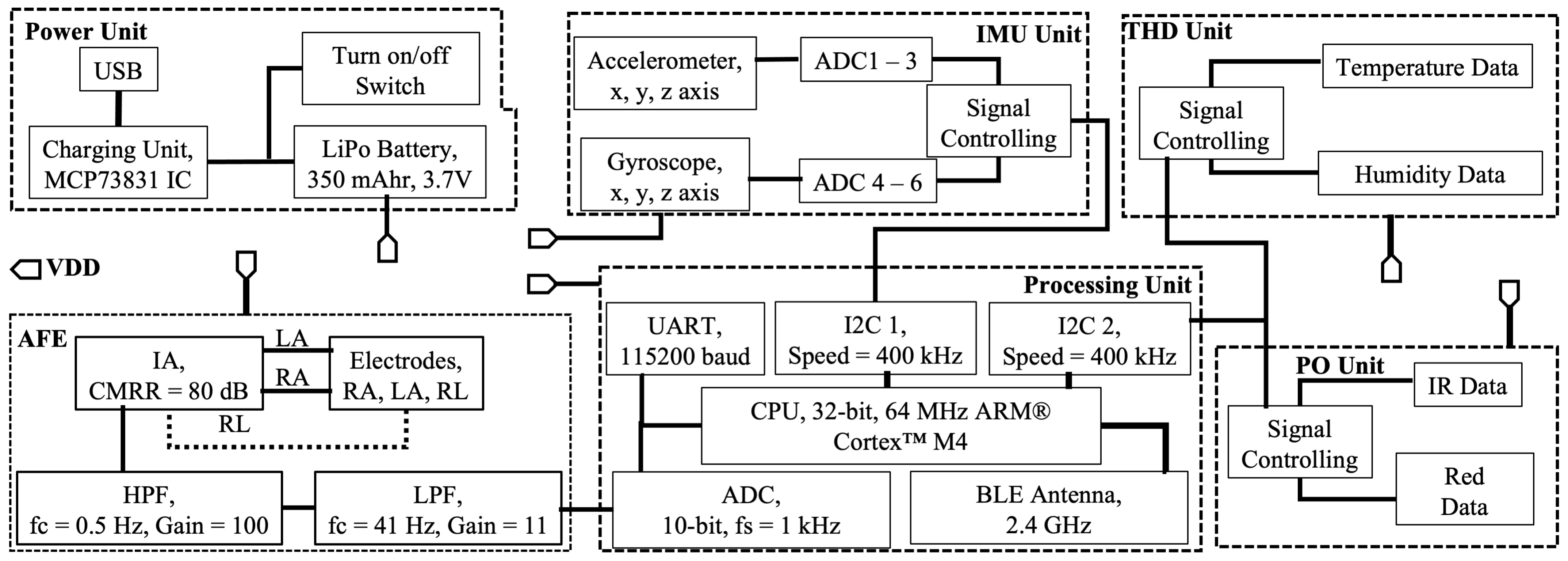
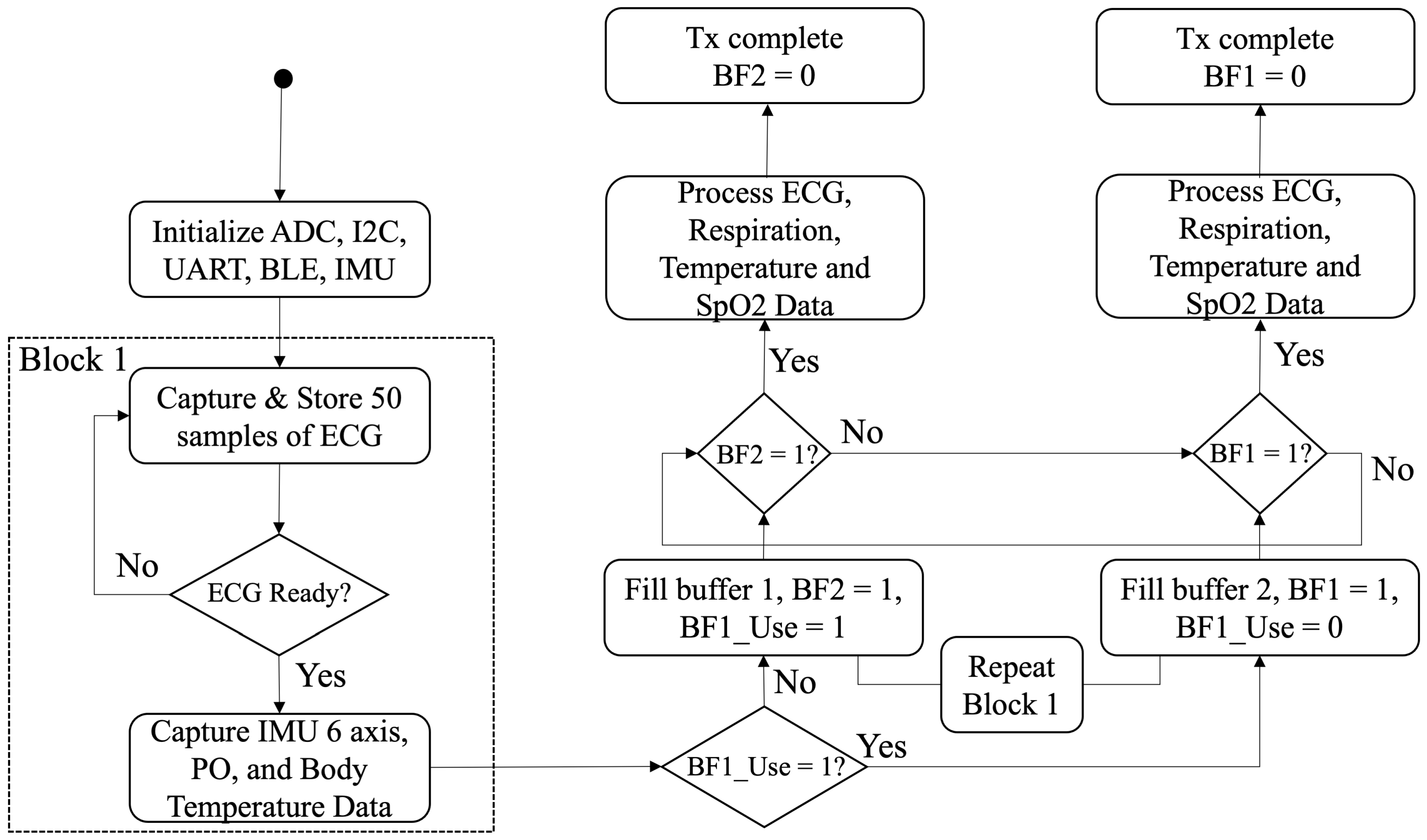



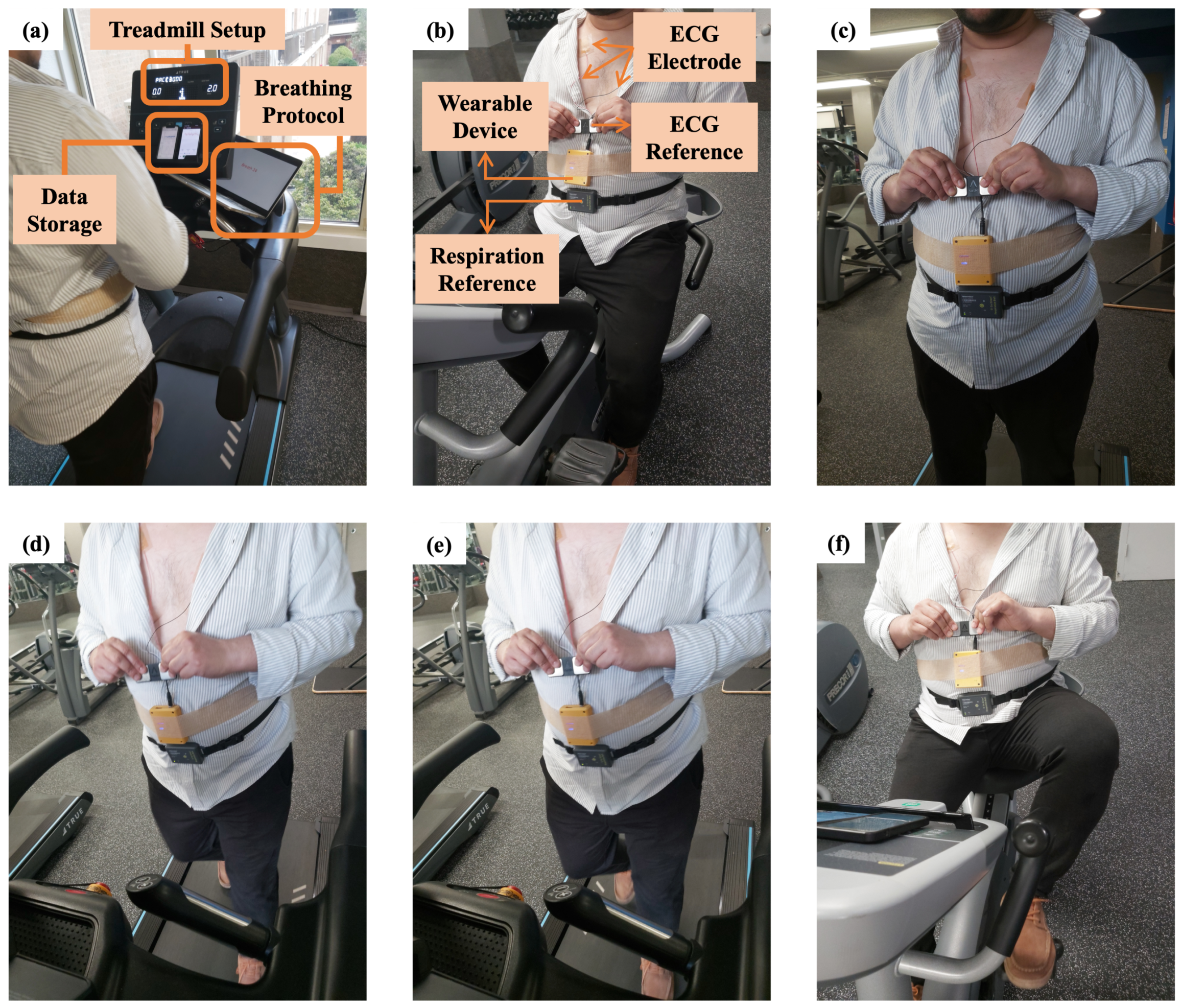


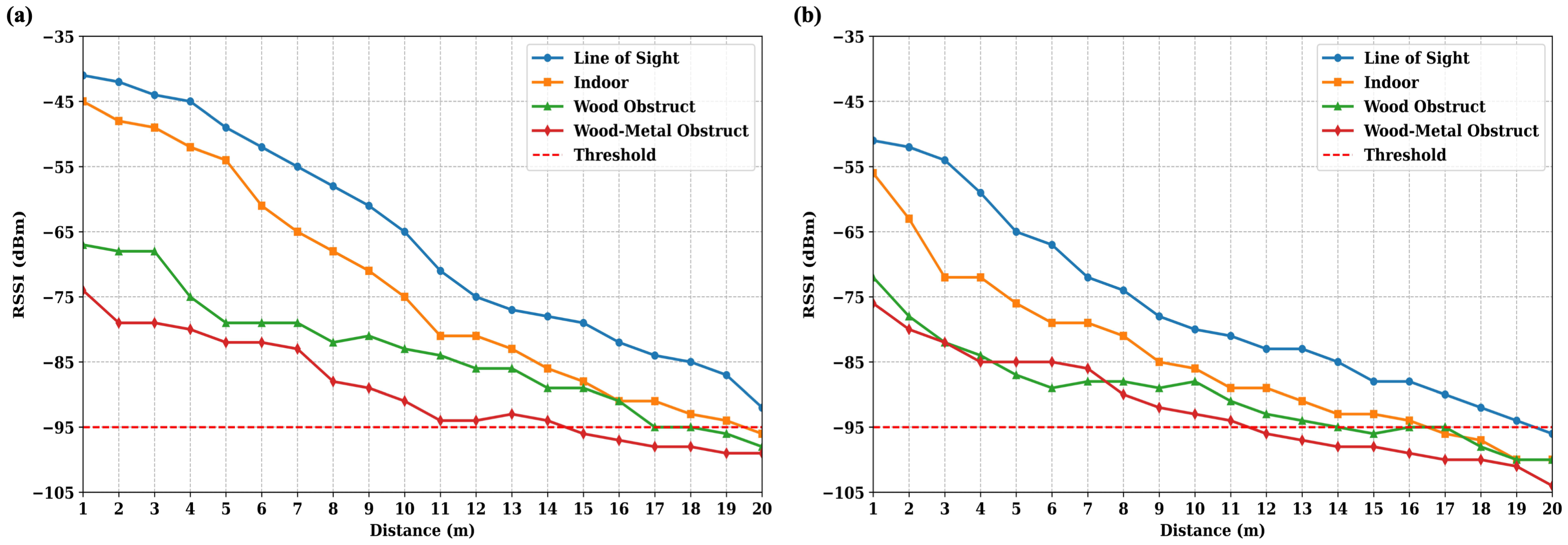

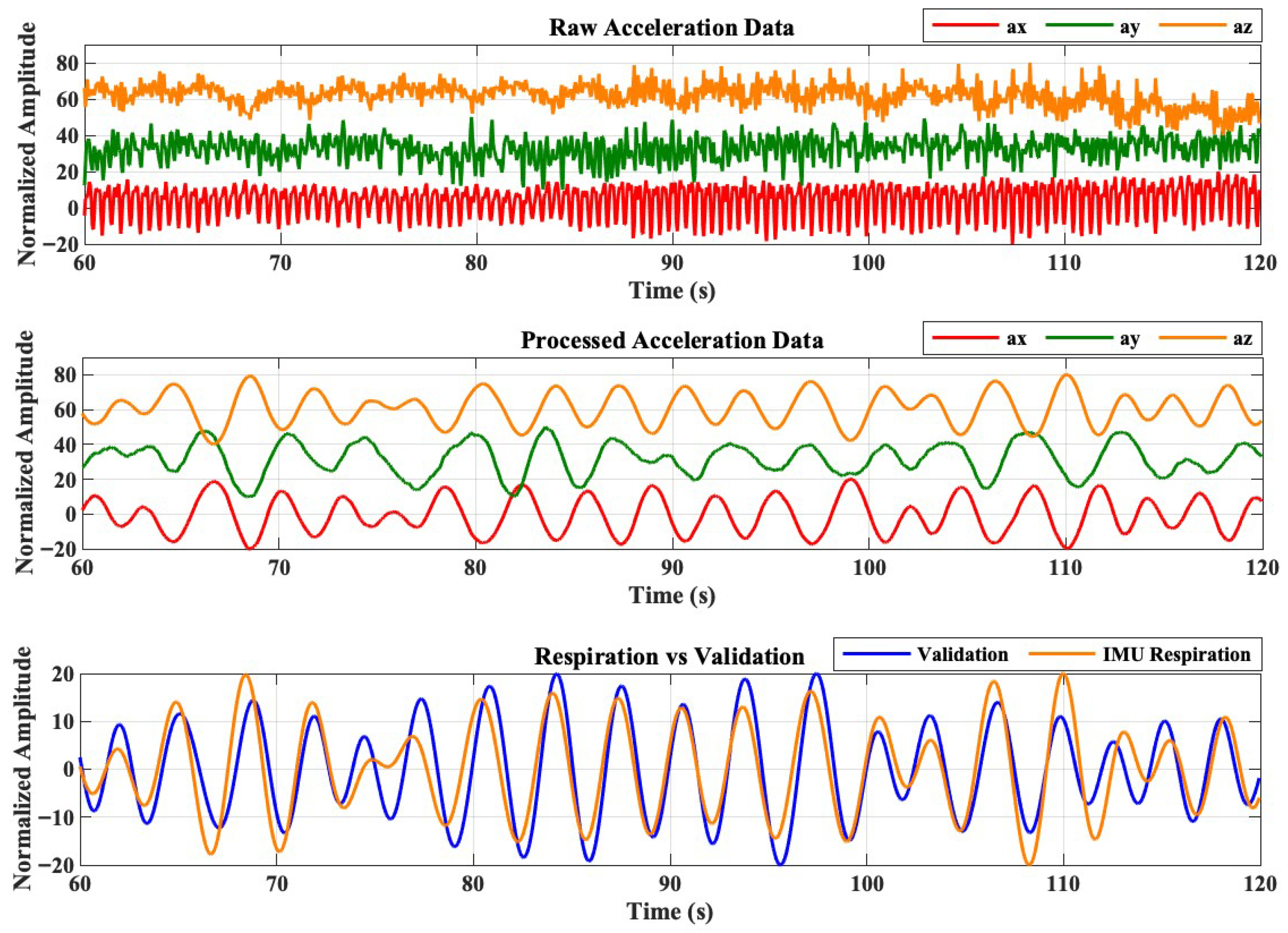



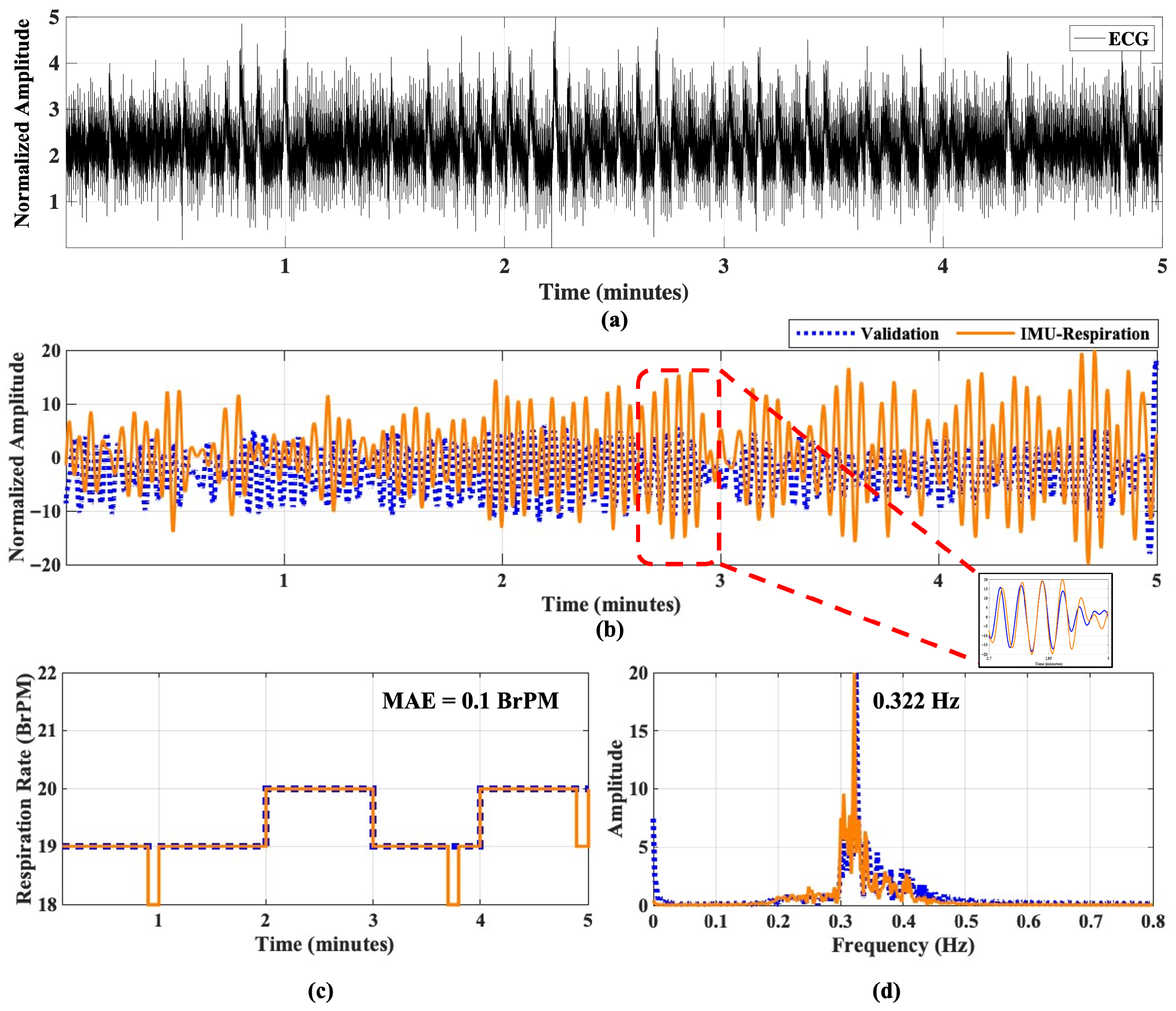
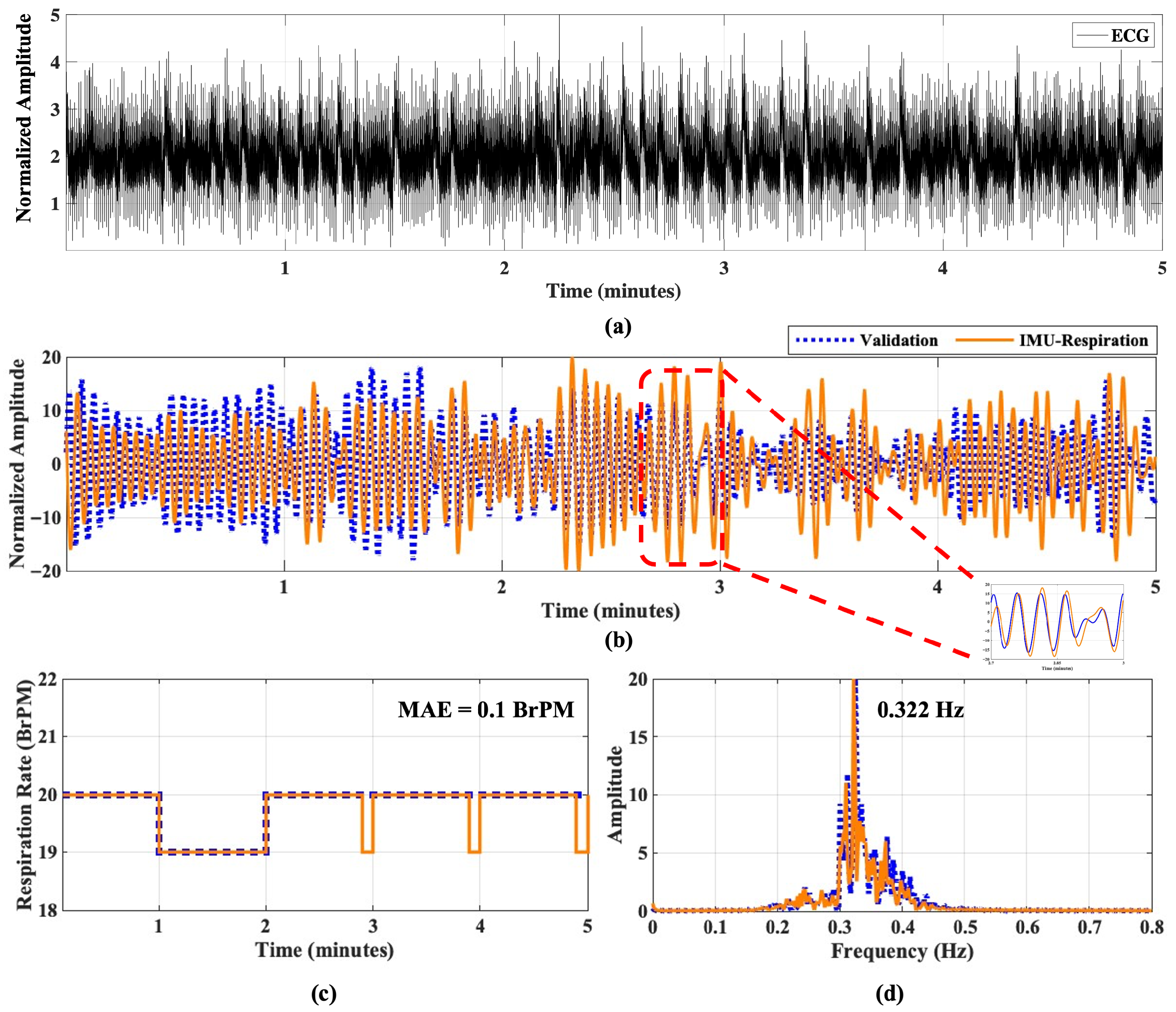

| BLE Packet Number | Packet Description | Payload Size (Bytes) |
|---|---|---|
| 1–50 | Raw ECG | 400 |
| 51 | ECG Features | 400 |
| 52–57 | Raw IMU (6 axis) | 400 |
| 58 | Respiration | 200 |
| 59–60 | Raw PO | 400 |
| 61 | Raw Temperature | 200 |
| 62 | RR, Mean SpO2, Mean Temperature | 6 |
| Test # | Posture | Breathing Pattern | BrPM | Duration (mins) |
|---|---|---|---|---|
| Test 1 (static) | Sitting & Standing (all phases) | Phase 1: Inhale 1 s–Exhale 1 s Phase 2: Inhale 1.25 s–Exhale 1.25 s Phase 3: Inhale 1.5 s–Exhale 1.5 s Phase 4: Inhale 2.5 s–Exhale 2.5 s | 30 24 20 12 | 1 1.25 1.5 1.25 |
| Test 2 (dynamic) | Walking | Inhale 1 s – Exhale 1 s | 20 | 5 |
| Running | Inhale 1 s–Exhale 1 s | 20 | 5 | |
| Cycling | Inhale 1 s–Exhale 1 s | 20 | 5 | |
| Test 3 (ambulatory) | Include sitting, standing, walking, stair stepping | Normal breathing | - | 20 |
| BLE Properties | Iavg, mA | Imax, mA | ||
|---|---|---|---|---|
| Speed | Connection Interval | Sleep Mode | ||
| 1 mbps | 50 ms | Yes | 7.39 | 36.97 |
| 1 mbps | 50 ms | No | 16.47 | 43.47 |
| 2 mbps | 50 ms | Yes | 7.25 | 39.37 |
| 2 mbps | 50 ms | No | 16.35 | 43.48 |
| 1 mbps | 20 ms | Yes | 11.31 | 41.34 |
| 1 mbps | 40 ms | Yes | 11.18 | 41.22 |
| Data Processing | Latency, ms |
|---|---|
| ECG processing | 59.3 |
| Respiration processing | 1.4 |
| PO processing | 0.55 |
| Temperature processing | 0.02 |
| Test | Posture | MAEHR (BPM) | AccuracyHR (%) | MAERR (BrPM) | AccuracyRR (%) |
|---|---|---|---|---|---|
| Test 1 (stationary) | Sitting | 0.19 | 99.05 | 0.14 | 99.25 |
| Standing | 0.22 | 98.79 | 0.12 | 99.34 | |
| Test 2 (dynamic) | Walking | 0.31 | 97.90 | 0.17 | 99.17 |
| Running | 0.33 | 97.73 | 0.36 | 98.01 | |
| Cycling | 0.28 | 98.25 | 0.23 | 98.61 |
| Ref. | Sensor | Device | Processing Platform | Posture/Activity | Application | Performance |
|---|---|---|---|---|---|---|
| Montes et al. [21] | Textile patch | Hexoskin smart shirt | recording device connected, real time | 1.5, 2.5, 3.5 mph walking | HR, RR | rHR = 0.86, rRR = 0.87 |
| Hashimoto et al. [65] | Textile sensor | C3 fit IN-Pulse bioelectrode | On-device | Moderate work | HR | MAPE = 0.92% |
| Ali et al. [56] | Capacitive sensing | Capaciflector textile sensor | Offline | Sitting | RR | Acc: 99.39% |
| Grover et al. [55] | Humidity sensing | IMP crystal-based humidity sensor | Offline | Normal/deep breathing | - | = 75 s; = 18 s |
| Romero et al. [57] | PPG-based | In-ear PPG sensor to extract respiration | Offline | Sitting | RR, TV | MAE: 1.96 |
| Bhongade et al. [52] | Single IMU on coastal region | ARM Cortex-M7, 600 MHz, data in SD card | CNN in MATLAB | Sitting | RR | MAE: 0.04 |
| Cheng et al. [49] | Distributed IMU front/back | Array of XsensDOT IMU, BLE Tx | Mobile computing | Standing, sitting, walking, squatting | Motion inference, RR | MAE: 0.8 |
| Angelucci et al. [58] | 3 IMU front/back | Mesh network among sensor nodes | CNN applied offline | Static, dynamic | Human activity, RR | Acc: 98% |
| Berkebile et al. [35] | Impedance pneumography | Tetrapolar electrode thoracic patch, SD card | MATLAB | Sitting, supine, walking, stairs | TV, RR | MAPE: 0.93%; RTE: 4.5% |
| Qui et al. [36] | Impedance pneumography | Chest patch, BLE-LoRa Tx | On-device, real time | Sitting, standing, supine, lying, walking, running, cycling, ambulatory indoor-outdoor | RR | Acc: 97.8% (static), Acc: 98.5% (dynamic) |
| This work | IJP electrode, Single IMU on thorax–abdomen | Biopotential and Motion sensing, BLE Tx | On-device, real time | Sitting, standing, walking, running, cycling, dynamic indoor-outdoor | HR, RR | Static: AccHR = 98.9%, AccRR = 99.3%, Dynamic: AccHR = 97.9%, AccRR = 98.6% |
Disclaimer/Publisher’s Note: The statements, opinions and data contained in all publications are solely those of the individual author(s) and contributor(s) and not of MDPI and/or the editor(s). MDPI and/or the editor(s) disclaim responsibility for any injury to people or property resulting from any ideas, methods, instructions or products referred to in the content. |
© 2025 by the authors. Licensee MDPI, Basel, Switzerland. This article is an open access article distributed under the terms and conditions of the Creative Commons Attribution (CC BY) license (https://creativecommons.org/licenses/by/4.0/).
Share and Cite
Rahman, M.; Morshed, B.I. CardioResp Device: Hardware and Firmware of an Embedded Wearable for Real-Time ECG and Respiration in Dynamic Settings. Electronics 2025, 14, 4276. https://doi.org/10.3390/electronics14214276
Rahman M, Morshed BI. CardioResp Device: Hardware and Firmware of an Embedded Wearable for Real-Time ECG and Respiration in Dynamic Settings. Electronics. 2025; 14(21):4276. https://doi.org/10.3390/electronics14214276
Chicago/Turabian StyleRahman, Mahfuzur, and Bashir I. Morshed. 2025. "CardioResp Device: Hardware and Firmware of an Embedded Wearable for Real-Time ECG and Respiration in Dynamic Settings" Electronics 14, no. 21: 4276. https://doi.org/10.3390/electronics14214276
APA StyleRahman, M., & Morshed, B. I. (2025). CardioResp Device: Hardware and Firmware of an Embedded Wearable for Real-Time ECG and Respiration in Dynamic Settings. Electronics, 14(21), 4276. https://doi.org/10.3390/electronics14214276







